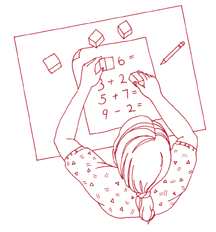

How do you feel about math? Your feelings will have an impact on how your children think about math and themselves as mathematicians. Take a few minutes to answer these questions:
![]() Do you think everyone can learn math?
Do you think everyone can learn math?
![]() Do you
think of math as useful in everyday life?
Do you
think of math as useful in everyday life?
![]() Do you
believe that most jobs today require math skills?
Do you
believe that most jobs today require math skills?
If you answer "yes" to most of these questions, then you are probably encouraging your child to think mathematically. Positive attitudes about math are important for your child's success.
Helping your child learn to solve problems, to communicate mathematically, and to demonstrate reasoning abilities are fundamental to learning mathematics. These attributes will improve your child's understanding of and interest in math concepts and thinking. Before beginning the activities in this book, let's first look at what it means to:
![]() Be a Problem Solver,
Be a Problem Solver,
![]() Communicate Mathematically, and
Communicate Mathematically, and
![]() Demonstrate Reasoning Ability.
Demonstrate Reasoning Ability.
A problem solver is someone who questions,
investigates, and explores solutions to problems; demonstrates the ability to
stick with a problem to find a solution; understands that there may be different
ways to arrive at an answer; considers many different answers to a problem; and
applies math to everyday situations and uses it successfully. You can encourage
your child to be a good problem solver by involving him or her in family
decision making using math. 
To communicate mathematically means to use words, numbers, or mathematical symbols to explain situations; to talk about how you arrived at an answer; to listen to others' ways of thinking and perhaps alter their thinking; to use pictures to explain something; and to write about math, not just give an answer. You can help your child learn to communicate mathematically by asking your child to explain a math problem or answer. Ask your child to write about the process she or he used, or to draw a picture of how he or she arrived at an answer to a problem.
Reasoning ability means thinking logically, being able
to see similarities and differences about things, making choices based on those
differences, and thinking about relationships among things. You can encourage
your child to explain his or her answers to easy math problems and to the more
complicated ones. As you listen, you will hear your child sharing his or her
reasoning.
1. Problems Can Be Solved in Different Ways While some problems in math may have only one solution, there may be many ways to get the right answer. Learning math is not only finding the correct answer, it's also a process of solving problems and applying what you have learned to new problems.
2. Wrong Answers Can Help! While accuracy is always important, a wrong answer could help you and your child discover what your child may not understand. The wrong answer tells you to look further, to ask questions, and to see what the wrong answer is saying about the child's understanding. It is highly likely that when you studied math, you were expected to complete lots of problems using one, memorized method and to do them quickly. Today, the focus is less on the quantity of memorized problems and memorized methods and more on understanding the concepts and applying thinking skills to arrive at an answer.
3. Doing Math in Your Head Is Important
4. It's Okay to Use a Calculator
As a result of the recent effort in mathematics teaching to include understanding in the teaching of math, from basic through advanced levels, the picture of your child's math class may, indeed, look different from what you remember when you were in school. For instance: